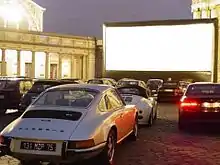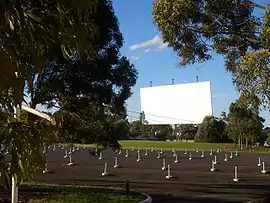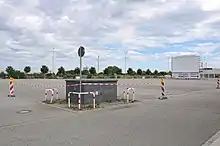Drive-in theater
A drive-in theater or drive-in cinema is a form of cinema structure consisting of a large outdoor movie screen, a projection booth, a concession stand, and a large parking area for automobiles. Within this enclosed area, customers can view movies from the privacy and comfort of their cars. Some drive-ins have small playgrounds for children and a few picnic tables or benches.
The screen can be as simple as a wall that is painted white, or it can be a steel truss structure with a complex finish. Originally, the movie's sound was provided by speakers on the screen and later by individual speakers hung from the window of each car, which were attached by wire. These systems were superseded by the more practical method of microbroadcasting the soundtrack to car radios. This also allows the soundtrack to be picked up in stereo by the audience on in-car stereo systems, which are typically higher in quality and fidelity than the simple speakers used in the old systems.
History
Early drive-ins (before WWII)
A partial drive-in theater—Theatre de Guadalupe—was opened in Las Cruces, New Mexico, on April 23, 1915:
Seven hundred people may be comfortably seated in the auditorium. Automobile entrances and places for 40 or more cars within the theater grounds and in-line position to see the pictures and witness all performances on the stage is a feature of the place that will please car owners.[1]
The first movie shown by the Theatre de Guadalupe was Bags of Gold, produced by Siegmund Lubin. Theatre de Guadalupe soon was renamed De Lux Theater before closing in July 1916.[2]
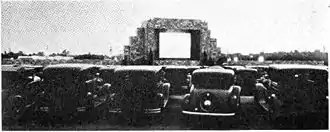
In 1921, a drive-in was opened by Claude V. Caver in Comanche, Texas. Caver obtained a permit from the city to project films downtown. With cars parked bumper-to-bumper, patrons witnessed the screening of silent films from their vehicles.[3] In the 1920s, "outdoor movies" became a popular summer entertainment, but relatively few "drive-in" experiments were made due to logistical difficulties.
The drive-in theater was patented in Camden, New Jersey by chemical company magnate Richard M. Hollingshead, Jr.,[4] whose family owned and operated the R.M. Hollingshead Corporation chemical plant in Camden. In 1932, Hollingshead conducted outdoor theater tests in his driveway at 212 Thomas Avenue in Riverton. After nailing a screen to trees in his backyard, he set a 1928 Kodak projector on the hood of his car and put a radio behind the screen, testing different sound levels with his car windows down and up. Blocks under vehicles in the driveway enabled him to determine the size and spacing of ramps so all automobiles could have a clear view of the screen. Hollingshead applied for a patent of his invention on August 6, 1932, and he was given U.S. Patent 1,909,537 on May 16, 1933.[5]
Hollingshead's drive-in opened in New Jersey June 6, 1933, on Admiral Wilson Boulevard in Pennsauken Township,[6] a short distance from Cooper River Park. Rosemont Avenue now runs through where the theater was.[7][8] It offered 400 slots[8] and a 40 by 50 ft (12 by 15 m) screen.[9][10] He advertised his drive-in theater with the slogan, "The whole family is welcome, regardless of how noisy the children are."[11] The first film shown was the Adolphe Menjou film Wives Beware.[9][12][13] Failing to make a profit, Hollingshead sold the theater after three years to a Union, New Jersey, theater owner who moved the infrastructure to that city, but the concept caught on nationwide.[14]
The April 15, 1934, opening of Shankweiler's Auto Park in Orefield, Pennsylvania, was followed by Galveston's Drive-In Short Reel Theater (July 5, 1934), the Pico Drive-In Theater at Pico and Westwood boulevards in Los Angeles[15] (September 9, 1934) and the Weymouth Drive-In Theatre in Weymouth, Massachusetts (May 6, 1936). In 1937, three more opened in Ohio, Massachusetts and Rhode Island, with another 12 during 1938 and 1939 in California, Florida, Maine, Maryland, Massachusetts, Michigan, New York, Texas and Virginia.
Early drive-in theaters had to deal with sound issues. The original Hollingshead drive-in had speakers installed on the tower itself which caused a sound delay affecting patrons at the rear of the drive-in's field. In 1935, the Pico Drive-in Theater attempted to solve this problem by having a row of speakers in front of the cars.[16] In 1941, RCA introduced in-car speakers with individual volume controls which solved the noise pollution issue and provided satisfactory sound to drive-in patrons.[17] Just before World War II, 9 of the 15 drive-in movie theaters open in the United States were operated by Philip Smith, who promoted a family-friendly environment by allowing children to enter free and built playgrounds.[18]
Peak (late 1940s–1960s)
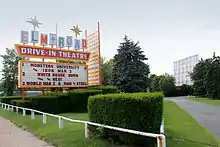

After 1945 rising car ownership and suburban and rural population led to a boom in drive-in theaters, with hundreds being opened each year. More couples were reunited and having children, resulting in the Baby Boom, and more cars were being purchased following the end of wartime fuel rationing. By 1951, the number of drive-in movie theaters in the United States had increased from its 1947 total of 155 to 4,151.[19]
The drive-in's peak popularity came in the late 1950s and early 1960s, particularly in rural areas, with over 4,000 drive-ins spread across the United States in 1958.[15] They were a cheaper alternative to in-door cinema theaters because not only did they save the gas of driving out to the city and then back home, but the cost of building and maintaining a drive-in theater was cheaper than that of an in-door theater, resulting in lower overall cost of attendance.[19] Among its advantages was the fact that older adults with children could take care of their infant while watching a movie, while youth found drive-ins ideal for a first date. Unlike indoor cinema theaters, there was an air of informality which was appealing to people of all ages, but specifically to families. The drive-in's success was rooted in its reputation of being a family-friendly place. Parents were able to bring their children to the theater, often in pajamas, without having to worry about bothering other movie-goers, and were also able to spend time together without paying the expenses of babysitters. Drive-ins catered to their known audience, offering luxuries such as bottle warmers and diaper vending machines, and later miniature golf courses, swimming pools, and even motels on the land with windows facing the screens so that viewers could watch the films from their beds.[19] During the 1950s, the greater privacy afforded to patrons gave drive-ins a reputation as immoral, and they were labeled "passion pits" in the media. The 1978 movie Grease portrays the local drive-in as a preferred spot for trysts.
At their height, some drive-ins used attention-grabbing gimmicks to boost attendance. They ranged from drawings for prizes and free admission, small airplane runways, helicopter or hot air balloon rides,[20] unusual attractions such as a small petting zoo or cage of monkeys, personal appearances by actors to open their movies, or musical groups to play before the show. Some drive-ins held Sunday religious services, or charged a flat price per car on slow nights like Wednesdays or Sundays. On "buck" nights during the 1950s and 1960s, the admission price was one dollar per car.
As revenue was more limited than regular theaters since showings could only begin at twilight, there were abortive attempts to create suitable conditions for daylight viewing such as large tent structures, but nothing viable was developed.

One of the largest drive-in theaters was the Johnny All-Weather Drive-In in Copiague, New York. Covering over 29 acres, it could park 2,500 vehicles. It had a full-service restaurant with seating on the roof, and a trolley system to take children and adults to a playground and a large indoor theater for bad weather or for those who wanted to watch in air-conditioned comfort.[21]
Decline (1970s–1990s)

Beginning in the late 1960s, drive-in attendance began to decline as the result of improvements and changes to home entertainment, from color television to cable TV, VCRs and video rental. Additionally, the 1970s energy crisis led to the widespread adoption of daylight saving time (which caused drive-in movies to start an hour later) and lower use of automobiles, making it increasingly difficult for drive-ins to remain profitable.
While exploitation films had been a drive-in staple since the 1950s, helped by relatively limited oversight compared to downtown theaters, by the 1970s several venues switched from showing family-friendly fare to R-rated and X-rated films as a way to offset declining patronage and revenue, while other venues that still catered to families, began to show R-rated or pornographic movies in late night time slots to bring in extra income. This allowed censored materials to be viewed by a wider audience, including those for whom viewing was still illegal in some states, and it was also reliant upon varying local ordinances controlling such material. It also required a relatively remote location away from the heavier populated areas of towns and cities.
The runaway inflation and real estate interest rate hikes in the late 1970s and early 1980s, made the large land tracts used by drive-ins increasingly expensive, and thus far too valuable for continued use as drive-ins. Many Drive-ins operated solely on weekends, while some were open only during the summer months; they were also subject to the whim of nature, as adverse weather often resulted in poor attendance or cancellations. By the late 1980s, the total number of drive-ins still operating in both the US and Canada fell to less than two hundred.
Many former drive-in movie sites remain, with several re-purposed as storage or flea market sites, often after residential housing or other higher value uses came to rural or sparsely populated areas where the drive-ins were located. Former drive-in properties in Michigan have become industrial parks, shopping centers, indoor theaters, and even churches (as with the Former Woodland Drive-In in Grand Rapids, MI). In Philadelphia, the South City Drive In became the location of the original Spectrum in the late 1960s, with a small portion of its old property line extending into what would become the (now-demolished) Veterans Stadium complex. (Today that small portion, combined with the original Spectrum location, is part of Xfinity Live! Philadelphia). Another example of a drive in-turned-flea market is Spotlight 88 in North Sewickley Township, Beaver County, Pennsylvania, which ended business as a drive-in after an F3 tornado destroyed much of the property on May 31, 1985. As a joke after the tornado hit, the owners put up in the "now-showing" sign Gone with the Wind. It was most likely copied from a Taylor, Michigan Drive in called Ecorse Drive-In. On July 16, 1980, a freak derecho storm with 150 mph straight line winds [22] swept the Drive-In away leaving only the "now-showing" sign with the letters "Now Playing Gone with the Wind". The screen was rebuilt, but business never recovered; by 1989, it was sold and now is the site of a Kroger grocery store.
Revival and new drive-in formats (late 1990s–2000s)
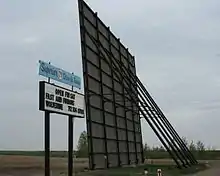

Beginning in the late 1970s, and extending through the mid-1990s, those drive-ins still operating acquired a quasi-novelty status, catering to the wave of "boomer nostalgia" and loyal patrons. This "retro" appeal eventually led to a revival of sorts by the end of the 1990s.
This resurgence of the drive-in industry led to the inception of the "do-it-yourself" drive-in beginning in 2001, which used contemporary tools such as LCD projectors and microradio transmitters. The first was the Liberation Drive-In in Oakland, California, which sought to reclaim under-used urban spaces such as vacant parking lots in the downtown area. The following years have had a rise of the "guerrilla drive-in" movement, in which groups of dedicated individuals orchestrate similar outdoor film and video screenings. Showings are often organized online, and participants meet at specified locations to watch films projected on bridge pillars or warehouses. The content featured at these screenings has frequently been independent or experimental films, cult movies, or otherwise alternative programming. Aside from Oakland's Liberation, the best-known "guerrilla" drive-ins include the Santa Cruz Guerilla Drive-In in Santa Cruz, California, North Bay Mobile Drive-In in Novato, California, MobMov in San Francisco, California and Hollywood, and more recently the Guerilla Drive-In Victoria in Victoria, British Columbia.
A similar, more recent concept is that of the "boutique" drive-in, which caters to a smaller audience, generally 30 to 50 vehicles (with some also offering seats in front of the screen), while food trucks are often used as concession stands. Unlike the "guerrilla" format, however, this type of drive-in also generally presents mainstream fare, both current releases and popular classics. A key feature of this format is the focus on the "vintage" aesthetics of the drive-in.
Faced with the closure of Hull's Drive In in Lexington, Virginia, in 1999, the nonprofit group Hull's Angels formed to raise funds, buy the property, and operate the theater as a nonprofit venture specializing in family-friendly films. Hull's continues to be the nation's only nonprofit drive-in.[23]
By 2006, around 500 drive-in theaters were open in the United States, counting both regularly operating venues (around 400) and those that held showings sporadically, usually during summertime, the highest number since the mid-1970s. The industry also had a rebound in Canada and Australia during the early 2000s.
Present and digital conversion (late 2000s onwards)
Beginning in the second half of the 2000s, drive-ins had another decline because of the oil crisis and a worsening economy. Reduced use of automobiles and more people moving out of suburban and rural areas during the 2010s have also put the future of the drive-in at risk, with numbers again on the decline. By 2013, drive-ins comprised only 1.5% of total movie screens in the United States, with 389 theaters in operation nationwide, mostly located in the South and the West Coast (at the industry's height, about 25% of the nation's movie screens were at drive-ins).[15] A figure of 348 operating drive-ins was published for the United States in March 2014[24][25]
In fall 2014, retro-themed burger chain Johnny Rockets announced that it would team up with USA Drive-Ins to open 200 drive-ins by 2018 serving Johnny Rocket's food at the concession stands,[26] but the plan never came to fruition, as did a proposed "Project Drive-In" scheme by Honda, which would have donated digital projectors. By 2018, less than 300 drive-in theaters were reported to operate worldwide, with only a handful outside North America.
The ongoing conversion of film distribution from celluloid to digital is also putting additional pressure on drive-in theaters. Most small drive-ins lack the finances (beginning at $70,000 per screen) needed to convert to digital projection.[15] The low volume of ticket sales from the lack of multiple showings also makes justifying the cost of installing digital projection hard for many drive-ins. Conversion of the projection booth to digital is more complex for drive-in theaters. The projector needs a more powerful bulb due to an increased screen size and light pollution. In addition, digital projection equipment may require an Internet connection, and the booth must be retrofitted with special glass, more vents, and stronger air conditioning, as well as heat in northern climates.[15]
With installation of Jumbotrons[27] or similar digital display equipment in drive-in theatres, restrictions of the projector booth can be avoided; that is, no projector is needed.
The move to digital conversion took its toll on the industry; while by October 2019, figures for operating drive-in theaters rose to 305, because of increased numbers of smaller 'boutique' operations that had never used traditional projectors, while several older drive-ins have closed.[28]
During the COVID-19 pandemic, drive-in theaters reported an unexpected surge in attendance in several U.S. states, as unlike with indoor theaters unable to operate because of bans on mass gatherings, these were allowed to operate, because people are automatically separated from each other by their cars, and usually enough space remains to walk around and still practice proper physical distancing.[29][30][31]
The largest drive-in theater in the world, the Fort Lauderdale Swap Shop (opened 1963), doubles as the world's largest daily flea market.
Drive-in theaters around the world
Australia
The drive-in theater also became popular in Australia during the 1950s and 1960s. The Hoyts Skyline in Melbourne was the country's first drive-in cinema, opening in 1954 with the film On the Riviera.[32] The drive-in was extremely successful, and four more opened within the year.[33] In ensuing years, the number of drive-ins increased across the country, particularly in Victoria, Tasmania, and New South Wales. As these drive-ins were based on the American trend, many served American-style food at snack bars. At the height of their popularity in the mid-1960s, around 330 drive-in theaters were operating in Australia, before quickly dropping off. As of 2016, only a dozen drive in theaters remained in Australia.
The world's most remote drive-in may be at Coober Pedy, South Australia. It opened in 1965, but became less popular after 1980 with the arrival of television to the town, and ceased regular operation in 1984. It was reopened in 1996.[34][35]
Germany
Germany's first drive-in theater, the Gravenbruch, opened in April 1960 in a suburb of Frankfurt with a screening of The King and I. The only other drive-ins in Europe at the time were in Rome, Italy and Madrid, Spain.[36]
Greece
Greece's first drive-in theater began construction in 1960 near Varibobi, a suburb of Athens, and was planned to open in August 1961.[37]
Iran
In 2020, Iran showed its first drive-in film, Exodus, during the COVID-19 pandemic.[38][39]
Philippines
The Philippines' shopping mall chain SM Supermalls opened the country's first drive-in theater near SM City Pampanga on July 31, 2020. [41] It also opened a temporary drive-in cinema at the SM Mall of Asia concert grounds on September 9, 2020. [42]
See also
References
- "A New Comer To Las Cruces". The Rio Grande Republican. 16 April 1915. p. 1.
- Thomas, David G. (2015). Screen With A Voice - A History of Moving Pictures in Las Cruces, New Mexico. Doc45 Publications. pp. 43–44, 168. ASIN B018CYWZ4O.
- "Claude Caver Dies at Home". Dallas Morning News. 1959-02-20. p. 5.
- "The "Drive-in" Movie" (PDF). Electronics. New York: McGraw-Hill Publishing Co. 6 (8): 209. August 1933. Retrieved October 25, 2014.
- "Richard Hollingshead and the First Drive-In Theater". About.com. Retrieved October 16, 2017.
- "82 years ago today, first U.S. drive-in theater opened in N.J." NJ.com. June 2015. Retrieved October 16, 2017.
- Strauss, Robert (July 23, 2004). "The Drive-In Theater Tries a Comeback; Looking for a Few Hundred Adventurous Moviegoers". The New York Times. Retrieved March 26, 2008.
The nation's first drive-in theater was built by the Hollingshead family along the tawdry Admiral Wilson Boulevard in Pennsauken, N.J., in 1933.
- "Movie theater lets cars drive right in". Popular Science. New York: Popular Science Publishing Co. 123 (2): 19. August 1933. Retrieved October 25, 2014.
- Lewis, Mary Beth. "Ten Best First Facts". Car and Driver (1/88): 92.
- Drive-In Movie Holds Four Hundred Cars. Popular Mechanics. Hearst Magazines. September 1933.
- "This Month in History". Smithsonian. June 2003.
- "PHOTOS: Happy birthday, drive-in movies, a N.J. invention". NJ.com. June 2014. Retrieved October 16, 2017.
- "The Victoria Advocate - Google News Archive Search". news.Google.com. Retrieved October 16, 2017.
- "Admiral Wilson Boulevard - Encyclopedia of Greater Philadelphia". PhiladelphiaEncyclopedia.org. Retrieved October 16, 2017.
- Nelson, Laura J. (2013-01-19). "Digital projection has drive-in theaters reeling". The Los Angeles Times. Retrieved 2013-01-19.
- Popular Mechanics. Hearst Magazines. October 1935. p. 528.
Popular Science 1935 plane Popular Mechanics.
- Fielding, Raymond (May 1968). Technological History of Motion Pictures and Television. University of California Press. p. 215. ISBN 978-0-520-00411-5.
- Harris, Kathryn (1985-08-11). "General Cinema More Wall St. Than Hollywood : Investments Pay Off Handsomely for Bottler and Theater-Chain Operator". Los Angeles Times.
- Fox, Mark A. (June 1, 2018). "DRIVE-IN THEATRES, TECHNOLOGY, AND CULTURAL CHA". Gale Academic Onefile.
- "farmingdale drive-in - Drive-In Theater Adventures". DriveInAdventures.Wordpress.com. Retrieved October 16, 2017.
- "Million-Dollar Drive-In Offers Films, Fun and Food". Popular Science. September 1957. pp. 119–121.
- "NWS Detroit/Pontiac -- July 16th, 1980, Derecho". noaa.gov.
- Philp, Rowan (17 July 2000). "The Best Picture Show; Drive-In Movie Fans Band Together To Keep a Screen From Going Dark". The Washington Post. Retrieved November 2, 2010.
- "Archived copy". Archived from the original on 2013-12-04. Retrieved 2013-12-01.CS1 maint: archived copy as title (link)
- Epstein, Adam. "There are barely any drive-in movie theaters left in the US". QZ.com. Retrieved October 16, 2017.
- Wong, Vanessa (October 1, 2014). "At Johnny Rockets, the Future of Retro is Drive In Movies". Business Week.
- "Old Linton Drive-In To Be Resurrected And Open By August [2012]". WBIW. Archived from the original on 2015-09-05. Retrieved 2013-09-11.
- "Headlights, Camera, Action: Drive-In Movie Theaters in the Northeast". Your AAA Network. 2019-11-28. Retrieved 2020-02-26.
- Wright, David (15 May 2020). "Rebirth of drive-in movie theaters". YouTube.com. Retrieved 29 July 2020.
- "The drive-in theater thrives, for a time (Associated Press)". YouTube.com. 21 March 2020. Retrieved 29 July 2020.
- Hoeller, Sophie-Claire (2020-04-05). "Drive-in movie theaters around the world are having a renaissance amid the coronavirus pandemic". Business Insider Nederland (in Dutch). Retrieved 2020-07-29.
- "Remembering Australia's Drive-ins". Inside the Collection. Retrieved 2019-12-04.
- Goldsmith, Ben (1999). "The Comfort Lies in All the Things You Can Do': The Australian Drive-in--Cinema of Distraction". Journal of Popular Culture. 33 (1): 153–164. doi:10.1111/j.0022-3840.1999.3301_153.x.
- "History of the Coober Pedy Drive-in". Retrieved 7 April 2019.
- Patrick Martin (7 April 2019). "Coober Pedy's desert drive-in cinema a feast for the eyes — and not just on-screen". Australian Broadcasting Corporation. Retrieved 7 April 2019.
- "Germany's First Ozoner Launched". Variety. May 11, 1960. p. 13. Retrieved February 6, 2021 – via Archive.org.
- "Greek's First Drive-In". Variety. July 6, 1960. p. 19. Retrieved February 6, 2021 – via Archive.org.
- "Iran's First Drive-in Cinema Launched amid COVID-19 Pandemic". Iran Front Page. 29 April 2020.
- "Iran to try first post-revolution drive-in theater with Exodus". Tehran Times (13653): 12. 30 April 2020.
- "Europe's 1st Drive-In At Rome". Variety. June 2, 1954. p. 2 – via Archive.org.
- Charlene A. Cayabyab (July 31, 2020). "Drive-in cinema at SM City Pampanga now open". SunStar Pampanga. Retrieved August 1, 2020.
- "SM Mall of Asia turns concert grounds into drive-in theater". ABS-CBN News.
Further reading
- Ephraim Katz, ed. (2001). "Drive-in". The Film Encyclopedia (4th ed.). New York: HarperCollins.
- Sanders, Don; Sanders, Susan (October 2003). The American Drive-In Movie Theater. Motorbooks International. ISBN 0-7603-1707-0.
- McKeon, Elizabeth; Everett, Linda; McKeon, Liz (December 1998). Cinema Under the Stars: America's Love Affair With the Drive-In Movie Theater. Cumberland House. ISBN 1-58182-002-X.
- Sanders, Don and; Sanders, Susan (2000). Drive-in Movie Memories. Middleton: Carriage House.
- Segrave, Kerry (1992). Drive-in Theaters: a History from Their Inception in 1933. Jefferson: McFarland and Company, Inc.
- "The Drive-in Theater History Page". Drive in Theater. 2007-04-20.
External links
| Wikimedia Commons has media related to Drive-in theaters. |
- "Honda Launches Project Drive-In to Save Drive-Ins Across the Country". 2013-08-12. Retrieved 2019-09-05.
- Davis, Matthew (2005-10-13). "Drive-in theatres refuse to fade away". BBC. Retrieved 2019-09-05.
- Mclaughlin, Lisa (2006-08-07). "Movies that star the stars". Time Magazine. Retrieved 2019-09-05.
- Solomon, Karen (2007-07-30). "MobMov creates a new guerrilla theater while reviving drive-in culture". San Francisco Chronicle. Retrieved 2019-09-05.
- Mullane, Nancy (2008-04-21). "For Drive-In Theaters, an Unexpected Revival". All Things Considered. NPR. Retrieved 2019-09-05.
- "A freely downloadable collection of drive-in intermission advertisements".
- Conner, Robin; Johnson, Paul (2008-10-10). "Starlit Screens: Preserving Place and Public at Drive-In Theaters". Southern Spaces. doi:10.18737/M7B60Q. Retrieved 2019-09-05.
- Banks, David (2009-09-11). "Will the endangered American drive-in fade to black?". CNN. Retrieved 2009-09-14.
- "United Drive-In Theatre Owners Association". Retrieved 2019-09-05.
- Kuipers, Richard. "Australian Drive-In theatres". Australian Screen. National Film and Sound Archive of Australia. Retrieved 2019-09-05.
their depiction in Australian films
- Litton, Jeffrey. "Garden State Drive In Chronology". Retrieved 2019-09-05.
- "lists all currently open drive-in theaters in the U.S., Canada and Australia. The site is constantly updated with openings and closures". DriveInMovie.com. Retrieved 2019-09-05.
